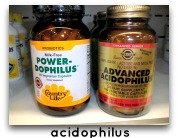- Home
- Acidophilus
Acidopholus

Acidophilus or Acidopholus as it's often spelled, can help after a sore throat, ear infection, acne skin breakout, during pregnancy, or other ailment if a patient took antibiotics. Antibiotics are given on a regular basis in hospitals. They work fast and are reliable for emergency situations. But, little advice or information about the side effects of antibiotic treatment are told to patients.
It may be days or months after the antibiotic treatment is given that a patient notices other disturbing changes in their body, which are directly related to the antibiotics that were administered in the hospital. Antibiotics kills the bad bacteria it needs to kill, but at the same time, it kills the friendly bacteria that normally lives inside our intestines. We need the friendly bacteria to balance out the yeast that lives within us as well. When we don't have the right balance, yeast can grow to out number our friendly bacteria.
Also Known As: Lactobacillus acidophilus, L. acidophilus, lactic acid bacteria
Common Misspelling: acidophilous
Benefits
Lactobacillus acidophilus is Latin for acid-loving milk-bacterium. It's job is to ferment sugars into lactic acid. In 1856, Louis Pasteur discovered Lactobacillus and the connection to the making of lactic acid. It can be found inside food like yogurt, cottage cheese, raw sauerkraut, kombucha (a fermented drink made from teas, sugar, and live cultures), and many other fermented food.
A person will usually need to take a dosage in the Billions (anywhere from 1-10 Billion or more) several times a day after meals. The dosage will be on the label and refers to the number of live active cultures/bacteria.
Acidopholus supplements can be found as powders, tablets, liquid, and capsules. They should be stored in the refrigerated section of health food stores in dark bottles. Refrigeration stops the bacteria from dying.
People take acidopholus for many different reasons. Taking probiotics has an associated health benefit of boosting the immune system and it's been studied for that purpose. Reasons for taking acidophilus include:
- The need to repopulate the gastrointestinal tract after an antibiotic treatment.
- Help digestion in those who are lactose-intolerant.
- Increase production of Vitamin K.
- Relieve constipation.
- Prevent traveler's diarrhea.
- Prevent yeast infections or Candida albicans.
- Reduce symptoms of cough, runny nose, and fever.
Probiotics found in health food stores are living microbial food supplements. The work by living inside a host to improve intestinal functions and provide micoflora balance.
Exmples of "good" bacteria that help our gut include Acidopholus or Lactobacillus, Bifidus and Bulgaricus. When we take these probiotics as food supplements, they kill the “bad” bacteria which allows more space for good bacteria to proliferate.
Not only are they good for killing bad bacteria but some doctors believe they may prevent diseases like colon cancer and reducing cholesterol. We find these probiotics in the refriderated section of health or nutrition stores. Freeze-dried Lactobacillus and Bifidus are the good versions of bacteria that we need in large amounts to kill bad bacteria. Other products include kefer, a creamy white drink where cow's milk has been fermented.
Keep in mind that acidophilus must contain live cultures in order to work for your body and be effective. If you've never done it before, it can be a little daunting to go into a health food store and try and find the right probiotic that's right for you. Sometimes the label will have other substances or contaminants inside which isn't what you want. Then, there's the possibility that the probiotic has been sitting on the shelf for a long period of time causing the reduction in the amount of acidopholus in the container.
Side-Effects
For most people, probiotics can be taken with no side effects except for minor occurrences of gas or stomach upset. In rare cases people with AIDS, organ transplants, artificial arteries, or weak immune systems may have more serious side effects and should consult with their doctor before using.

Popular Articles